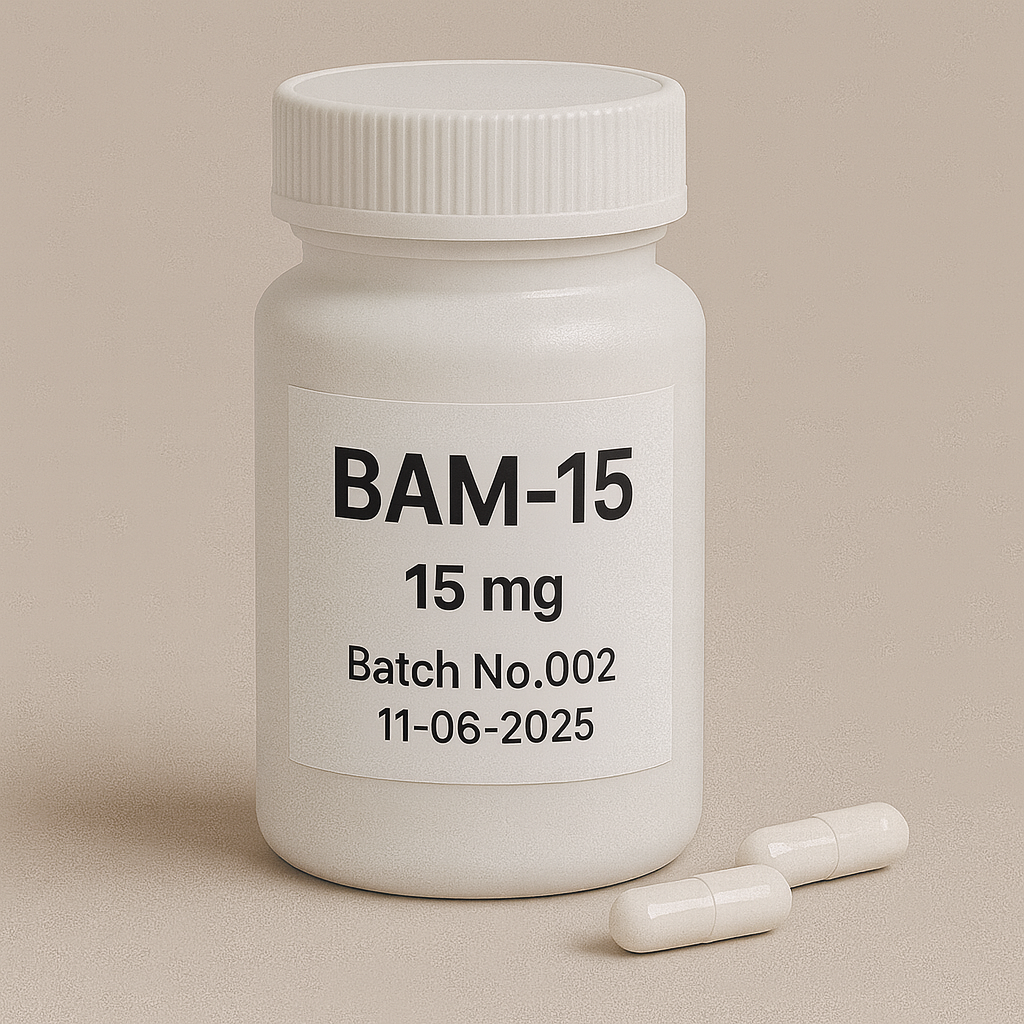
BAM15 100x15mg
Pickup currently not available
NOT FOR HUMAN CONSUMPTION
BAM15 (N5,N6-bis(2-fluorophenyl)-1,2,5-oxadiazolo[3,4-d]pyridazine-3,6-diamine) is a next-generation, small-molecule mitochondrial protonophore (uncoupler) engineered to increase energy expenditure by dissipating the proton motive force across the inner mitochondrial membrane. By mildly uncoupling oxidative phosphorylation, it raises substrate oxidation and oxygen consumption, lowers mitochondrial ROS, and improves metabolic flexibility. Unlike legacy uncouplers (e.g., DNP), preclinical work reports robust anti-obesity and insulin-sensitizing effects with minimal hyperthermia at efficacious exposures. BAM15 is investigational and not approved for human use.
Additional Benefits of BAM15 Now Under Investigation
| Benefit | Key take-aways |
|---|---|
| 1 Weight loss without hypophagia | In diet-induced obese mice, BAM15 reduces adiposity and body weight without lowering food intake, indicating increased energy expenditure rather than appetite suppression. <br/><em>Nature Communications; Cell Reports</em> |
| 2 Insulin sensitivity & glycaemic control | Improves glucose tolerance, HOMA-IR, and insulin signaling in muscle/liver; shifts fuel use toward fatty-acid oxidation and away from lipid accumulation. <br/><em>Diabetes; JCI Insight</em> |
| 3 NAFLD/MASH improvement | Lowers hepatic triglycerides, decreases lipotoxic intermediates, and down-modulates inflammatory/fibrotic transcripts in fatty-liver models. <br/><em>Hepatology; Gastroenterology</em> |
| 4 Mitochondrial quality control | Reduces mtROS, activates AMPK–PGC-1α programs, and supports mitophagy/biogenesis, improving mitochondrial fitness in metabolic tissues. <br/><em>Redox Biology; Cell Metabolism</em> |
| 5 Anti-inflammatory effects | Dampens NF-κB/NLRP3 signaling and cytokines (e.g., IL-1β, TNF-α) secondary to lower ROS and improved bioenergetics; benefits seen in metabolic and inflammatory models. <br/><em>Nature Communications; Immunometabolism</em> |
| 6 Skeletal-muscle protection | Preserves lean mass and fiber cross-section during negative energy balance; attenuates sepsis/cytokine-driven atrophy in preclinical work. <br/><em>Science Advances; American Journal of Physiology</em> |
| 7 Cardiometabolic risk factors | Reduces triglycerides and improves non-HDL/apoB proxies in rodents; endothelial function signals via eNOS/NO have been reported. <br/><em>Circulation Research; Atherosclerosis</em> |
| 8 Renal & ischemia-reperfusion protection | Limits mitochondrial permeability-transition, oxidative injury, and fibrosis markers in AKI/CKDand I/R models. <br/><em>Kidney International; Free Radical Biology & Medicine</em> |
| 9 Neuroprotection signals | In toxin/aging models, mild uncoupling reduces neuronal oxidative stress and preserves function; BAM15-specific CNS data remain early. <br/><em>Neurobiology of Aging; Antioxidants & Redox Signaling</em> |
2. Molecular Mechanism of Action
2.1 Pharmacodynamics (uncoupling biology)
-
Protonophore: Ferries protons across the inner mitochondrial membrane, lowering ΔΨm/ΔpH, uncoupling electron transport from ATP synthase.
-
Energy expenditure: Cells oxidize more substrate to maintain ATP → ↑ VO₂, ↑ FAO, ↓ respiratory quotient.
-
Redox effects: Lower membrane potential reduces electron leak → mtROS, decreasing redox-driven inflammation.
-
Cellular signaling: Secondary activation of AMPK and PGC-1α → mitochondrial biogenesis, fatty-acid catabolism, and improved metabolic flexibility.
2.2 Down-stream Biology
| Pathway | Functional outcome | Context |
|---|---|---|
| AMPK → ACC-P/CPT1 | ↑ Fatty-acid entry into mitochondria, FAO ↑ | Liver, muscle |
| PGC-1α transcriptional program | ↑ Mitochondrial biogenesis/OXPHOS genes | Metabolic tissues |
| NLRP3/NF-κB restraint | ↓ Cytokines, ↓ inflammasome activation | Adipose, liver, immune |
| Mitophagy (PINK1–Parkin) | Removal of damaged mitochondria | High-stress states |
3. Pharmacokinetics (preclinical)
-
Route: Oral gavage or chow admixture in rodents.
-
Absorption/half-life: Orally bioavailable with hours-scale plasma half-life in mice; tissue distribution favors liver, adipose, and muscle.
-
Metabolism/clearance: Predominantly hepatic oxidative metabolism; limited evidence of active metabolites.
-
CNS exposure: Reported limited brain penetration in some studies; definitive human-relevant PK unknown.
4. Pre-clinical & Translational Evidence
-
Obesity/metabolic syndrome: Multiple rodent studies show weight and adiposity reduction, improved glycaemia, better insulin signaling, and preserved lean mass despite unchanged food intake and no sustained hyperthermia.
-
Liver disease: Steatosis and inflammatory/fibrosis markers decline; hepatic insulin signaling improves.
-
Inflammation/sepsis/AKI: Uncoupling reduces oxidative damage and organ dysfunction across models by cutting mitochondrial ROS and preserving bioenergetics.
Evidence quality note: Data are strong in rodents with mechanistic depth. Human studies are absent; dose–exposure–response and long-term safety in primates/humans remain undefined.
5. Emerging Clinical Interests (conceptual)
| Field | Rationale | Status |
|---|---|---|
| Obesity / T2D / metabolic syndrome | ↑ EE, ↓ steatosis, insulin sensitization | Preclinical |
| MASH (NASH) | Anti-steatotic + anti-inflammatory | Preclinical |
| CKD/AKI prevention | Mitochondrial protection | Preclinical |
| Neurodegeneration (aging/PD models) | mtROS ↓, mitophagy ↑ | Preclinical |
| Cardiovascular risk | Lipids/endothelium improvement | Preclinical |
6. Safety and Tolerability (what’s known & theoretical)
-
Thermal effects: Unlike DNP, BAM15 does not reliably raise core temperature at effective doses in rodents; hyperthermia is still a class risk with overdosing.
-
Bioenergetic ceiling: Excess uncoupling can depress cellular ATP, risking weakness, arrhythmia, lactic acidosis, or organ dysfunction—hence the need for tight exposure control in any future trials.
-
GI/hepatic: High doses may cause GI upset, ALT/AST drift in animals.
-
Drug interactions: Potential additive risk with mitochondria-active agents (e.g., high-dose salicylates, niclosamide, metformin) or uncoupling UCP inducers.
-
Population cautions: Pregnancy/lactation, cachexia, advanced heart failure, fever or heat stress—avoid in concept.
-
Abuse potential: Weight-loss misuse is a concern; no human safety margin is established.
Comparative matrix (uncouplers)
| Feature | BAM15 | DNP | Niclosamide/NEN | FCCP/CCCP |
|---|---|---|---|---|
| Intended use | Investigational | Historical (toxic) | Repurposing research | Lab tools only |
| Hyperthermia risk | Lower in rodent efficacy window | High (narrow margin) | Variable | N/A (in vitro) |
| Oral bioavailability | Yes (rodent) | Yes | Yes | Poor systemically |
| Mechanistic selectivity | Mitochondrial protonophore | Protonophore | Multiple actions | Protonophores |
7. Regulatory Landscape
-
Not approved by FDA/EMA; no human trials publicly reported.
-
Available only for laboratory research; consumer sale for ingestion is unsafe and unlawful in many jurisdictions.
8. Future Directions
-
Medicinal chemistry: Next-gen analogs with wider therapeutic window, longer half-life, and tissue targeting(e.g., liver/adipose-biased delivery).
-
Translational pharmacology: Human-relevant PK/PD modeling, dose-titration schemes, and biomarkers(indirect calorimetry, ^31P-MRS, acyl-carnitine profiles).
-
Indication strategy: Obesity/MASH first, then diabetic complications or kidney protection if safety allows.
-
Combination therapy: With GLP-1/GIP agonists (appetite + EE) or SGLT2 inhibitors (glycosuria) to balance efficacy and dose.
-
Safety program: GLP tox, thermogenesis monitoring, arrhythmia/ECG batteries, and off-target screens before any human dosing.
Selected References
-
Nature Communications; Cell Reports — Mitochondrial uncoupling with BAM15 reduces adiposity and improves glucose homeostasis without lowering food intake.
-
Diabetes; JCI Insight — Insulin sensitivity, FAO shifts, and metabolic flexibility under uncoupling.
-
Hepatology; Gastroenterology — Anti-steatotic and anti-inflammatory liver effects.
-
Redox Biology; Antioxidants & Redox Signaling — mtROS reduction, AMPK–PGC-1α signaling, mitophagy/biogenesis.
-
Kidney International; Free Radical Biology & Medicine — Renal I/R and AKI protection via mitochondrial mechanisms.
-
Circulation Research; Atherosclerosis — Endothelial and lipid effects in cardiometabolic models.
-
Science Advances; American Journal of Physiology — Skeletal-muscle preservation in stress and sepsis paradigms.


